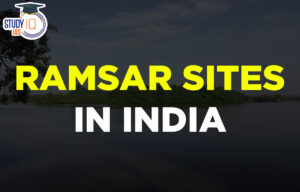Table of Contents
Context: India has conducted its first-ever detailed population survey of Gangetic dolphins, the only riverine dolphins in the country.
About Ganges River Dolphin
- It was declared as India’s National Aquatic Animal in 2009.
- It is one of the 4 freshwater dolphin species in the world. The other 3 are the baiji (Yangtze River), bhulan (Indus, Pakistan) and the boto (Amazon River).
- Distribution: It is found in the Ganga, Brahmaputra-Meghna and Karnaphuli-Sangu river systems in India, Nepal and Bangladesh.
- Dolphin Sanctuary: Vikramshila Gangetic Dolphin Sanctuary in Bihar.

About Population Survey of Gangetic Dolphins
- Total population estimate: 6,234
- Ganga basin population: 5,689
- Brahmaputra basin population: 635
- Beas River: 3 (Indus River Dolphins).
- Bihar: Most dolphin-friendly state due to ideal river morphology and higher water depth.
- Chausa-Manihari stretch (590 km): 1,297 dolphins, making it one of the densest populations in India.
- The study was conducted by the Wildlife Institute of India (WII) along with state forest departments and non-profit organizations like Aaranyak, WWF, Turtle Survival Alliance and Wildlife Trust of India.
Features of Ganges River Dolphin
- Long, pointed snout with sharp teeth.
- Poor eyesight; relies on echolocation to navigate and hunt.
- It can live only in Freshwater
- Females are larger than males and give birth to one calf every two to three years.
- Dolphins can not breathe out of the water. It surfaces every 30-120 seconds to breathe in fresh air as it is a mammal.
Conservation Status
Conservation efforts include the Project Dolphin initiative launched in India in 2020 to protect and rejuvenate their habitats.
- IUCN Status: Endangered
- CITES: Appendix I
- Wildlife Protection Act (WPA): Schedule I
| Project Dolphin |
The Ganges River Dolphin (Platanista gangetica) is a freshwater dolphin found in the Ganges-Brahmaputra-Meghna and Karnaphuli-Sangu river systems in India, Nepal, and Bangladesh. It is one of the few freshwater dolphin species in the world and is often referred to as the “Susu” due to the sound it produces while breathing.
|
Threats to Ganges River Dolphin
- Habitat Degradation: Pollution from industries, agriculture, etc. & construction of dams and barrages also fragment habitats, reducing population connectivity.
- Water Abstraction: Excessive withdrawal of water for agriculture and industry impacts river flow.
- Riverbed Alteration: Sand mining and dredging disrupt habitats.
- Accidental entanglement in fishing nets.
- Pollution (chemical waste, sewage, industrial effluents).
- Habitat destruction due to river modifications like dams and barrages.


 Ramsar Sites in India 2025 List: Names, ...
Ramsar Sites in India 2025 List: Names, ...
 List of National Parks in India 2025, Ch...
List of National Parks in India 2025, Ch...
 Bonnet Macaques: Habitat, Features, Beha...
Bonnet Macaques: Habitat, Features, Beha...

























